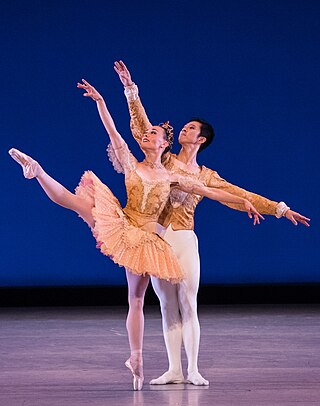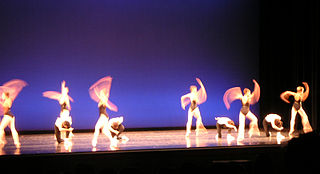
George Balanchine was a Georgian-American ballet choreographer, recognized as one of the most influential choreographers of the 20th-century. Styled as the father of American ballet, he co-founded the New York City Ballet and remained its artistic director for more than 35 years. His choreography is characterized by plotless ballets with minimal costume and décor, performed to classical and neoclassical music.

New York City Ballet (NYCB) is a ballet company founded in 1948 by choreographer George Balanchine and Lincoln Kirstein. Balanchine and Jerome Robbins are considered the founding choreographers of the company. Léon Barzin was the company's first music director. City Ballet grew out of earlier troupes: the Producing Company of the School of American Ballet, 1934; the American Ballet, 1935, and Ballet Caravan, 1936, which merged into American Ballet Caravan, 1941; and directly from the Ballet Society, 1946.

Suzanne Farrell is a former American ballerina and the founder of the Suzanne Farrell Ballet at the Kennedy Center in Washington, D.C.
Le Baiser de la fée is a neoclassical ballet in one act and four scenes composed by Igor Stravinsky in 1928 and revised in 1950 for George Balanchine and the New York City Ballet. Based on Hans Christian Andersen's short story Isjomfruen, the work is an homage to Pyotr Ilyich Tchaikovsky, for the 35th anniversary of the composer's death. Stravinsky elaborated several melodies from early piano pieces and songs by Tchaikovsky in his score. A commission by Ida Rubinstein from 1927, the ballet was choreographed by Bronislava Nijinska and premiered in Paris on 27 November 1928.

Apollo is a neoclassical ballet in two tableaux composed between 1927 and 1928 by Igor Stravinsky. It was choreographed in 1928 by twenty-four-year-old George Balanchine, with the composer contributing the libretto. The scenery and costumes were designed by André Bauchant, with new costumes by Coco Chanel in 1929. The scenery was executed by Alexander Shervashidze, with costumes under the direction of Mme. A. Youkine. The American patron of the arts Elizabeth Sprague Coolidge had commissioned the ballet in 1927 for a festival of contemporary music to be held the following year at the Library of Congress in Washington, D.C.

Theme and Variations is a ballet choreographed by George Balanchine to the final movement of Tchaikovsky's Orchestral Suite No. 3. The ballet was made for Ballet Theatre, and premiered on November 26, 1947, at the City Center 55 Street Theater, with the two leads danced by Alicia Alonso and Igor Youskevitch.

Agon is a 22-minute ballet for twelve dancers with music by Igor Stravinsky. It was choreographed by George Balanchine. Stravinsky began composition in December 1953 but was interrupted the next year; he resumed work in 1956 and concluded on April 27, 1957. The music was premiered in Los Angeles at UCLA's Royce Hall on June 17, 1957, conducted by Robert Craft. Stravinsky himself conducted the sessions for the work's first recording the following day on June 18, 1957. Agon was first performed on stage by the New York City Ballet at the City Center of Music and Drama on December 1, 1957.
The Suzanne Farrell Ballet is a ballet company housed at the Kennedy Center, Washington, D.C., and founded in 2000 by Suzanne Farrell, one of George Balanchine's most celebrated ballerinas, and a former New York City Ballet principal dancer. Until 2017, the Suzanne Farrell Ballet was a full-fledged company produced by the Kennedy Center and had performed there since 1999 in addition to presenting extensive national and international tours. In September 2016, the Center announced that the company would be disbanding at the end of 2017, citing "possibilities of new expansion" and indicating that Farrell would likely return to "full-time teaching."
Circus Polka: For a Young Elephant was written by Igor Stravinsky in 1942. He composed it for a ballet production that the choreographer George Balanchine did for Ringling Bros. and Barnum & Bailey Circus. The ballet was performed by fifty elephants and fifty ballerinas. In 1944, Stravinsky published an orchestration of the piece, which is now part of the repertoire of many orchestras.
Symphony in Three Movements is a neoclassical ballet choreographed by George Balanchine to the music of the same name by Igor Stravinsky. The ballet was made for the New York City Ballet Stravinsky Festival in 1972, a tribute to the composer following his death. The ballet premiered on June 18, 1972, at the New York State Theater.
The Cage is a ballet choreographed by Jerome Robbins to Stravinsky's Concerto in D. The ballet depicts a tribe of female insects that preys on their male counterparts, in which the Novice falls in love with a male intruder, before being overcome by her animal instincts to kill him. The Cage was made for the New York City Ballet, and premiered on June 10, 1951, at the City Center of Music and Drama, with Nora Kaye as the Novice.
Elegy is a composition by Igor Stravinsky for solo viola composed in 1944. It was dedicated to the memory of Alphonse Onnou, the founder of the Pro Arte Quartet. The score bears no time signature, but the metronome marking sets the tempo at = 56. The opening section is in the style of a chant above a rippling accompaniment. The middle section contains elements of a fugue, though there are never more than two independent voices. After its climax, the Elegy closes with a recapitulation of its opening. The viola is directed to play with mute throughout.
Variations is a ballet made by New York City Ballet co-founder and founding choreographer George Balanchine to Stravinsky's Variations: Aldous Huxley in memoriam (1963–64). The premiere took place on Thursday, 31 March 1966 at the New York State Theater, Lincoln Center; Balanchine made a new version for City Ballet's 1982 Stravinsky Centennial Celebration.
Ragtime (II) is the third ballet made by New York City Ballet's co-founder and balletmaster George Balanchine to Igor Stravinsky's Ragtime for Eleven Instruments (1918). The premiere took place on July 15, 1966, at Philharmonic Hall, New York. The first City Ballet performance was on January 17, 1967, at New York State Theater, Lincoln Center. The previous ballets made to Stravinsky's Ragtime were Ragtime (I) for City Ballet in 1960 and one of a number of "informal little things" made in St. Petersburg in 1922.
Requiem Canticles is a ballet made by New York City Ballet co-founder and balletmaster George Balanchine to eponymous music from 1966 by Igor Stravinsky in memoriam Martin Luther King, Jr. It received a single performance on May 2, 1968, at the New York State Theater, Lincoln Center, conducted by Robert Irving with Margaret Wilson, contralto, and John Ostendorf, bass. Costumes and candelabra were by Rouben Ter-Arutunian and lighting by Ronald Bates, the corps de ballet in long white robes bearing a three-branched candelabra. A lone woman searches among them and at the end a figure in purple representing Martin Luther King, Jr., is raised aloft.
Scherzo à la Russe is a ballet choreographed by George Balanchine to Stravinsky's music of the same name. The ballet was created for New York City Ballet's Stravinsky Festival, a tribute to the composer after his death, and premiered on June 21, 1972, at the New York State Theater, with the two lead roles originated by Karin von Aroldingen and Kay Mazzo.
Danses concertantes is the title of a work for chamber orchestra written in 1941–42 by Igor Stravinsky, commissioned by Werner Janssen. Stravinsky's music has been used for eponymous ballets by numerous choreographers attracted by its danceability.
Stravinsky Violin Concerto, originally titled Violin Concerto, is a neoclassical ballet choreographed by George Balanchine to Stravinsky's Violin Concerto. Balanchine had previously choreographed another ballet to the concerto in 1941 for the Original Ballet Russe, titled Balustrade, though it was not revived following a few performances. He then reused the concerto for New York City Ballet's Stravinsky Festival in 1972, a tribute to the composer following his death. The ballet premiered on June 18, 1972, at the New York State Theater.
Movements for Piano and Orchestra is a neoclassical ballet choreographed by George Balanchine to Stravinsky's score of the same name. The ballet premiered on April 9, 1963, at City Center of Music and Drama, performed by the New York City Ballet. Though the two lead roles were created for Diana Adams and Jacques d'Amboise, seventeen-year-old Suzanne Farrell danced the female lead at the premiere due to Adams' pregnancy. Starting in 1966, Movements and Monumentum pro Gesualdo (1960) are performed together.
Duo Concertant is a ballet choreographed by George Balanchine to Stravinsky's score of the same name. The ballet was created for New York City Ballet's Stravinsky Festival, a tribute to the composer a year after his death, and premiered on June 22, 1972, at the New York State Theater, danced by Kay Mazzo and Peter Martins.





